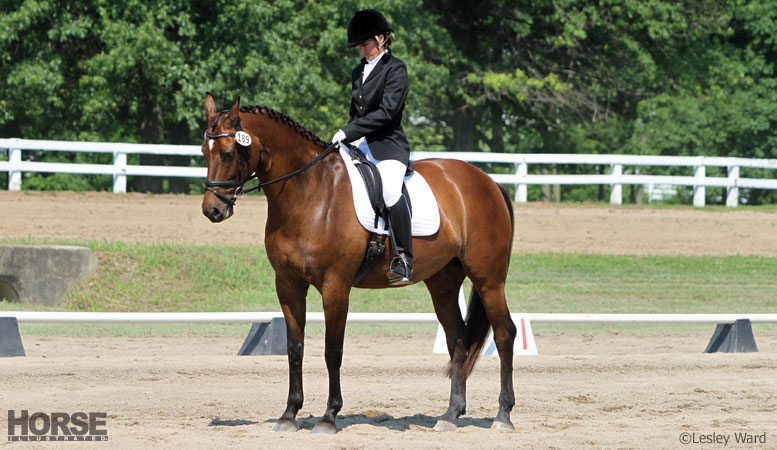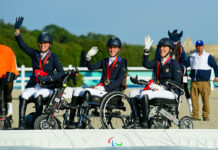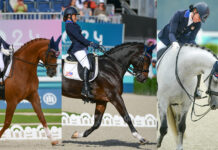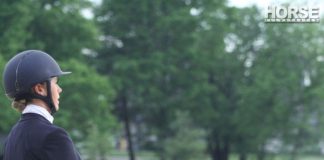Although it’s sometimes sought like the holy grail by dressage riders, a square halt is not to be valued as an end in itself, but for what it tells you about your horse’s development. Think of it as a measurement of progress. In fact, how a horse stands, either under saddle or in-hand, can tell you a lot. Obtaining consistent square halts is one of the best ways to tell if your training is heading in the right direction.

Instead, focus on the quality of work that precedes the halt. Through the practice of setting your horse up to execute balanced stops, you’ll improve the halt and, more importantly, his overall body mechanics. This will better his entire way of moving and performing.
Challenges you might face at the halt include:
- The horse braces his neck and ignores your request.
- The horse hollows his topline and loses his balance.
- The horse becomes crooked or swings his body around.
The following three exercises will help alleviate any or all of these challenges. They work by getting your horse to better use his body so that when you then ask him to halt, he won’t compromise his balance in the ways listed above.
|
Adjust Stride in Each Gait
Frequent adjustment of stride length within the trot, for example, keeps the hind legs active. This prevents them from trailing behind the body. Also, the practice of reducing your horse’s stride length and tempo helps keep him responsive and light on your aids, and eliminates any habit he may have of bracing his neck or pulling on the reins when asked for a downward transition. After riding lots of transitions within the various gaits, it will be much easier to get a prompt and square halt transition.
- Establish a steady working trot, tracking right.
- As you ride around the track, ask your horse to slow down for four strides each time you pass A, E, C and B.
- After each clear downshift in tempo, resume working trot.
- Once these transitions are happening smoothly, ask for four strides of a faster, bigger trot at each of those letters.
- Ride a few laps around the arena this way. Then, return to riding transitions to a slower and shorter trot at the letters.
- Catch your horse by surprise and ride a gentle, smooth downward transition to the halt. Be sure to transition first to the slower trot like you were doing previously. When you feel him respond, complete the halt transition. Your horse should be soft, balanced and engaged.
Ground Pole Square
One common cause of an unsquare halt is a horse careening through your aids when you ask him to stop—swinging his butt sideways, being late to stop, and falling sideways off his line of travel. A good way to get control over his feet is by using a ground pole square. This will help your horse organize his body by giving him a visual boundary. Halting inside the box with a pole behind his hind legs can also cure the bad habit of taking a step back after stopping. Repeatedly halting inside the space of the ground pole square allows your horse to practice clean halts without swinging sideways or stepping backward.
- Set up a square on the ground using four 8-foot poles.
- Develop a working trot and ride in a straight line toward the box.
- Ten meters from the box, transition down to a walk.
- Enter the box in a marching walk.
- Begin asking for the halt as soon as your horse’s front feet cross the first pole.
- Once his back legs have stepped into the box, you should be stopped.
- Stand quietly inside the box for several seconds with your horse remaining on the bit and attentive.
- Once this pattern is going smoothly, shorten the distance you walk into the box until you are trotting directly into it and halting.
Western Cloverleaf
If your horse initially stops square but then fidgets around and gets antsy or impatient, you can use the following exercise that many cowboys use to create balanced, quiet stops. It asks your horse to work very hard for a short burst and then offers him the chance to rest quietly in the halt. If he opts to fidget around instead of rest quietly, immediately hustle him back out on the pattern. Keep doing this until you are able to finish the pattern, drop the reins, and not feel him move a muscle under you.
Sometimes this exercise requires patience and multiple repetitions, but it nearly always works. It is far more effective than trying to discipline a horse for dancing around or giving stronger and stronger halt aids, which are increasingly futile. It uses the horse’s forward energy to your advantage. He soon learns that it is a lot less work to stand still, and the halt becomes enjoyable rather than a bore.
- Starting from a standstill, take off in a brisk trot or canter around the first “leaf” of a four-leaf clover pattern. (In a 20-meter wide dressage arena, each leaf will be about 10 meters in diameter.)
- Keep hustling around all four leaves.
- Park your horse in the center where you started, drop the reins, and sit quietly.
- As soon as he moves a foot or fidgets, shorten your reins and immediately take off for another trip around the cloverleaf pattern.
- Repeat step No. 3.
By practicing these exercises, you will avoid being one of those riders seen leaning off the side of her horse at the halt while trying to look under his belly to see if his feet are square. You can rest assured that he will be square because you have conditioned his body for it. Remember, as long as your halts are square, your training is moving in the right direction.
This article originally appeared in the January 2014 issue of Horse Illustrated. Click here to subscribe.






Great plan for the half halt – thanks.
These sound great.
great info, now I can understand it more